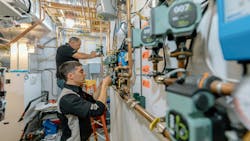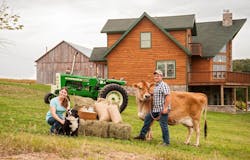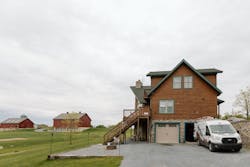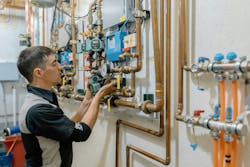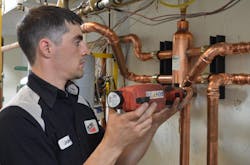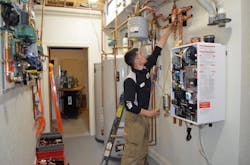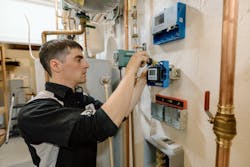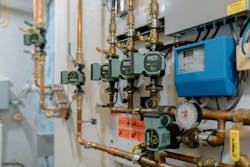Entrepreneurial Farmers Opt for Sustainable Hydronics
A decade ago, young farmers Keith and Jenessa Frey purchased a tract of land next to the family farm. The 60-acre parcel adjoined land the family had owned in Lancaster County, PA since 1895. Keith is now a fifth-generation farmer there.
Yet most of the Frey’s cash crop these days is grown thousands of miles away. Brazil, to be exact.
“Coffee beans don’t like our cold weather, yet we’ve become one of the region’s most popular coffee roasters,” said Janessa Frey.
The Frey’s own Lititz, PA-based Whiff Roasters, a rapidly growing enterprise that’s given them the freedom to use their farm as a place to raise a family, and horses.
Dream Home Comes to Life
Jenessa Frey’s dream for the family of four was for a home with loads of sunlight and a roomy kitchen. Keith Frey wanted radiant heat, geothermal energy, and a fireplace.
Their wishes took form in a 3,500 s.f., five-bedroom log home with a downstairs gym. Jenessa Frey’s kitchen occupies one end of the large open area on the main floor, blending easily into the great room with a tall stone fireplace.
Keith Frey built and equipped a space to serve as the sprawling mechanical system’s command and control center. Yet now, a decade later, they decided to refine the many interconnected plumbing and mechanical systems.
When trenching the insulated hydronic lines in 2014, they were careful to avoid excavation near an extensive geoexchange field. The geothermal tubing lies underneath a corn field behind the home and accommodates a four-ton water-to-air heat pump, chiefly installed for summer cooling.
A decade rolled by quickly as the Freys added children to the family, and their coffee enterprise. Keith, always with an eye on the mechanical systems, began to see room for improvement. He repaired a few leaks and also became aware of gradual, less-than-optimal operation.
Retrofit Specialists
The Freys chose Stevens, PA-based Vertex Mechanical to enhance system operation.
“The Freys did almost everything right from the beginning,” said Vince Youndt, president of the firm. “The existing mechanical systems were impressive, though they had a few performance issues, and the operational efficiency left room for improvement, largely due to lack of control between the various heat sources.”
After speaking with the Freys and studying their system design, Youndt found that when they built the home, the original installer used 1,900 lineal feet of ½-inch Watts PEX radiant tubing in the lower concrete slab and 3,160 feet of 3/8-inch Onix synthetic rubber tubing for the under-floor areas in a five-zone system that would warm most of the home’s floors. They also hung three prefabricated, pre-engineered Watts Hydronex panels to manage hydronic system flow.
“The infrastructure was ideal,” commented Youndt. “All of the fundamental, baseline needs were in place and in great condition.”
Jumping forward a decade, Youndt believed one key technology was needed for the improvement project. “The contribution of the tekmar 294 control is the ability to orchestrate multiple sources to feed the radiant heat and domestic water,” said Youndt.
“It also offers remote access to all important operational information, with the capability to monitor and control the entire system through any portable device or computer,” he added.
Youndt was relatively pleased with the existing system’s ability to heat and store domestic water. Yet, the back-up wall-hung boiler was having issues. He opted to install a new combi boiler to provide heat in the shoulder seasons when the large biofuel boiler wasn’t in use.
A Decade of Dirt and Grime
Youndt’s first order of business for the retrofit was to call Eric Grant, regional sales manager with Fernox. A week later, Grant appeared with the company’s PowerFlush flushing machine, a mobile system with pump and filtration, mounted on a dolly. He also brought several gallons of Fernox hydronic fluids.
After Youndt drained the Frey’s hydronic system, Grant connected to the main supply and return lines, refilling the system with clean water containing Fernox F3 cleaner. When the Powerflow flushing machine was powered on, water forcefully circulated through the entire network of pipes, tubes and components.
“The dirty liquid that returned to the machine quickly transitioned from a cloudy mix to a much clearer solution,” explained Grant.
Forty-five minutes later, the result of the chemical cleaning was made evident with crystal clear fluids returning to the flushing unit. It pushes up to 30 gallons a minute to scour-out and capture all the scale and debris that can collect in a hydronic system.
Before leaving the Youndt’s home, Grant left behind a couple gallons of Fernox F1 Protector, a solution for later maintenance of the system—all prearranged with Youndt.
New Design Takes Shape
Youndt also installed a 500 MBH Taco plate and frame heat exchanger, with circulation provided by a Taco 0015e3 pump. This unit provides transfer of heat from the biofuel boiler to the home’s DHW supply.
To accommodate the heat exchanger, Youndt redesigned the primary/secondary boiler supply loop to allow heat from the biofuel boiler to pass through the domestic water heat exchanger. The other route allowed the small backup boiler to provide heat to the domestic water indirect if the wood boiler was dormant.
The sensor monitoring for the Taco heat exchanger monitors inlet temp; anything above 160 degrees automatically uses the call for heat using the heat exchanger. If the temp dips below 160 degrees, the tekmar control taps the LP boiler for DHW heat.
Youndt also installed another key hydronic system component, a Taco hydraulic-separator. “The Hydro-Sep gives us a lot of flexibility with the multi-boiler application. It balances flow between the primary and secondary piping, protects the system from ferrous and non-ferrous debris, and also offers redundance with air elimination,” said Youndt.
Hydronics, Optimized
The enhanced system—now with the tekmar 294, coupled with tekmarNet controls—would soon provide an entirely new level of system operation, and management. “The refinements I envisioned took shape beautifully,” added Youndt.
“While the Taco Hydro-Sep assured optimal flow, the tekmarNet capability added advanced logic—a capability that simply wasn’t available until recently,” continued Youndt. “The Frey’s system now has what tekmar likes to refer to as ‘indoor feedback’—an ability not only to know what the zones are seeing and how they respond, but also the ability to modify boiler [or buffer tank] temperature based on room or zone temperatures.”
Youndt solved a problem of no wire connecting the main control panel and the wood boiler, 500 feet away, by installing a limit switch on the wood boiler. Its purpose: to activate the wood boiler’s local circulator, wirelessly tethered to a sensor at the hydraulic separator inside the house.
Both boilers were piped to feed heat into the hydronic system’s large buffer tank. The tank’s outdoor reset control, paired with a mixing valve, ensures the correct supply water temperature to the radiant floor circuits.
“Additional tekmar controls are key components of the Hydronex panels,” said Youndt. “The preassembled, pre-engineered Watts panels are remarkable; installers simply hang them, make connections, add power and water.”
The first, primary panel moves hot water from the boiler-fed buffer tank; it includes outdoor sensors and interior thermostats. Injection panels two and three parcel-out heated supply to feed the home’s different-temp radiant heat zones.
“The hydronic panels pull from the buffer tank to meet the home’s heat needs,” added Keith. Populating the Hydronex control panels and managing flow for all of the home’s five radiant heat zones are Taco zone controls, 00 Series ECM circulators, and Zone Sentry zone controls. The circs also control flow to and from both the buffer and indirect tanks. A Taco 4900 air separator ensures that the system isn’t oxygenated.
“We’ve installed Taco circs, pumps, zone valves and zone controls for years,” added Youndt. “With a system as robust as this one, there was no way we’d use anything but the products we’ve come to trust.”
“The district heating plan now works fabulously,” said Keith Frey.
Water Quality, Assured
The Freys have a good, on-site well. But—common to many agricultural areas—coliform bacteria and nitrates are present. After testing for water-borne minerals, sediment and other contaminants, it was clear to the Freys they’d need water treatment systems.
Well water now passes through sediment filters before flowing through an ultraviolet unit to kill bacteria. Domestic water then makes its way through a Watts OneFlow scale prevention system to control water hardness. The system’s scale media operates catalytically without salt or chemicals.
“It doesn’t even require electricity,” said an amazed Matt Woodcraft, president of Lifeflow Plumbing, who installed the water treatment, filtration and plumbing systems.
“The scale prevention is effective at preventing over 98 percent of the scale produced by the hard water,” added Woodcraft. “The only maintenance required on the system is a simple media replacement after three years of service.”
The final water treatment happens in the kitchen where Woodcraft installed an under-sink reverse osmosis system by Watts.
A Taco SmartPlug, paired with a 0015e3 stainless steel circulator, provides DHW recirculation through a dedicated return line to the indirect water heater. Without DHW circulation, the home’s large floorplan would result in long wait times for hot water to arrive at showers and fixtures.
Delayed Gratification
“Being my own GC added substantial time to complete the home,” said Keith Frey. “We saved a bundle, most of which allowed us to improve the home’s carbon footprint.”
“We never imagined having a home as comfortable as this one,” added Jenessa. “The floors were cozy warm all winter long, even with record low temps. We were so comfortable that we almost forgot about the fireplace.”
